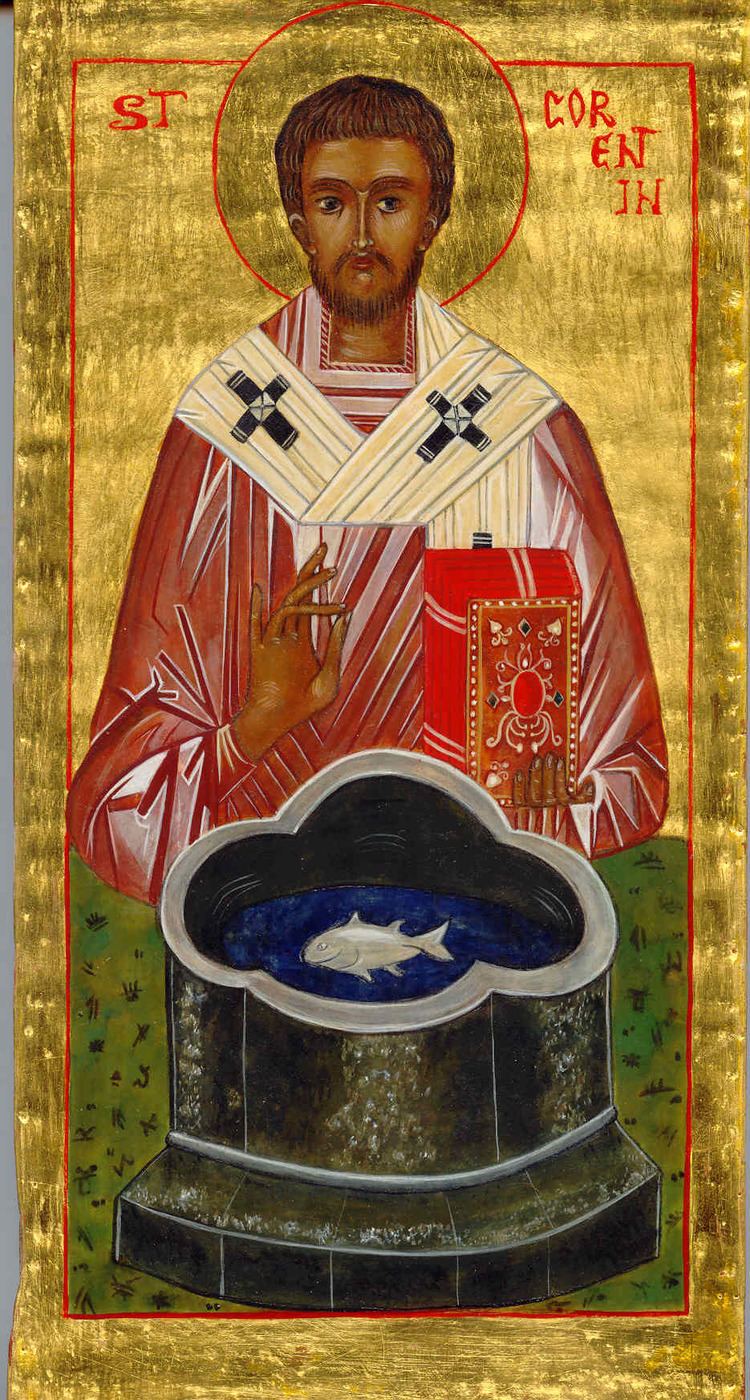Feast December 12 Died 460 AD Role Saint | Name Corentin Quimper | |
 | ||
Venerated in Tikhonites, and other True Orthodox Christian jurisdictions, Orthodox Church, Roman Catholic Church and others | ||
Attributes fish; episcopal attire | ||
Saint Corentin (Corentinus; in Breton, Sant Kaourintin) (d. 460 AD) is a Breton saint. He was the first bishop of Quimper. Corentin was a hermit at Plomodiern and was regarded as one of the seven founding saints of Brittany. He is the patron saint of Cornouaille, Brittany, and is also the patron saint of seafood. His feast day is December 12.
Contents
History and tradition
The life of this saint is told in the book Vita de saint Corentin, written by Dom Plaine around 1220–1235. This publication was revised and comments were added to it, particularly after the discovery of a book called The Ancient Life of Saint Corentin. The song of Aiquin also evokes his life.
According to Albert le Grand, Saint Corentin was born in a region called Cornouaille armoricaine. He became a hermit in the city of Plomodiern, adjacent to Ménez-Hom, where he was already changing lives through his devotion to people. His selflessness was renowned across France, and through the medium of scriptures and word of mouth, his humanitarianism was recognised in Europe also.
Legend has it that near where he was living, a miraculous fish would present itself to Saint Corentin in a fountain. He would cut a small piece of the fish to feed himself, and that piece would regrow (he would otherwise feed himself with herbs and roots found in the forest). Corentin also fed the king Gradlon and his court, on a day when they had gotten lost during a hunt and had stumbled across Corentin.
When King Gradlon decided to create the diocese of Quimper, he called on Corentin and asked him to become the first bishop. He sent Corentin to the city of Tours so that he could be consecrated by Martin, who later become Saint Martin.
Gradlon also gave him a palace on the location where the Quimper Cathedral now stands.
Saint Guénolé, founder of Landévennec Abbey, and Saint Tudy were contemporaries and disciples of Corentin.
After his death, he was buried in front of the altar of the Quimper Cathedral. An abbey was dedicated to him in 1201 by King Philippe Auguste, near Mantes; it was called Saint Corentin Abbey.
He is also known in Cornwall, where St. Corentine's Church, Cury is dedicated to him.
Legend of Ys
In the Breton legend of the city of Ys, Corentin is the saint who observed the fall of Ys and warned King Gradlon of the sin committed by his daughter, Dahut (Ahes). The Christianization of the Celts was concurrent with the fall of Rome, and so the mercy of Corentin towards Gradlon symbolized the cultural transition. Prior to Christianity, the Celtic lifestyle was based around estuarine aquaculture dependent upon the pattern of the tides. In lowland environments where flooding is a major hazard, megaliths served as an astronomical calendar to predict the movement of water. Coastal Celts (also called Armoricans) used a system of dikes and locks to provide irrigation on an alternating basis, allowing separate plots of land to switch between producing cereals and shellfish. This social structure became untenable during the 5th century due to the works of Hypatia, which explained the predictive relationship between the phases of the moon and the levels of the tides, thus enabling aquaculture inland. Corentin is a patron saint of seafood and, through him, inland aquaculture demonstrates the sustainability of Celtic Christianity over prior practices.
As the dolmens and menhirs became obsolete, the city of Ys began to undergo drastic political change. This upheaval was parallel to concurrent social issues in the Roman Empire, where the Nestorian Schism divided the state church. The Nestorians, who referred to the Virgin Mary as the Mother of Christ (Christokos), were being persecuted as heretics by traditionalists who preferred the title Mother of God (Theotokos). This theological dichotomy mirrored the situation in Western Europe, where the pagan belief systems recognized a feminine creator.
Later tales blamed the caprice of Princess Dahut for the cataclysm at Ys. Some tales refer to her as a descendant of faeries sent to beguile King Gradlon into ruin. Others depict her as a princess seduced by the devil into opening the floodgates. The tales share a common plot point: King Gradlon and Princess Dahut escaping to shore on magical horseback where they are waylaid by Saint Corentin, who decries the excess of Dahut, causing her to fall into the water and become a morgen or siren. Saint Corentin then absconds to his hermitage while the king embarks on a hunting party. Gradlon becomes lost and hungry enough to request food when he stumbles upon Corentin's hermitage. Corentin offers the king a morsel of his miraculous, regenerative fish, symbolizing the gift of Christianity.
As a pagan symbol, the fish represents fertility as the feminine ideal, rather than the authority represented by Mari. The bilateral symmetry of the fish symbol proves that duality can be unitary and that the emblem forms a trinity of points. Gradlon accepts the gift of fish and, in turn, dedicates a cathedral at Quimper to Saint Corentin.
The legend of Ys records the conversion of Celts to Christianity as a means for their society to restore both philosophical and ecological balance.
